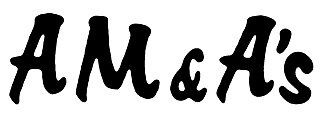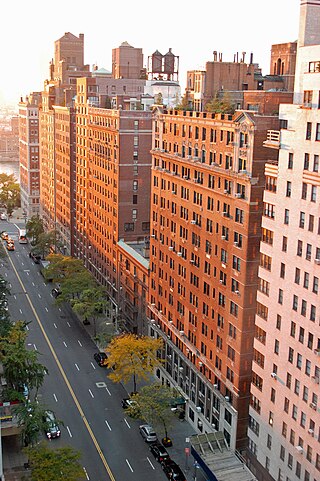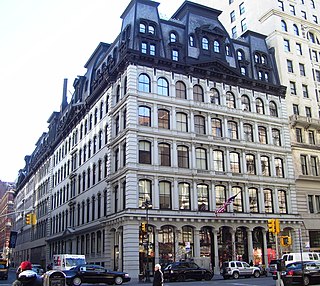
A department store is a retail establishment offering a wide range of consumer goods in different areas of the store, each area ("department") specializing in a product category. In modern major cities, the department store made a dramatic appearance in the middle of the 19th century, and permanently reshaped shopping habits, and the definition of service and luxury. Similar developments were under way in London, in Paris and in New York City (Stewart's).

Holt, Renfrew & Co., Limited is a Canadian luxury department store chain founded in 1837 by William S. Henderson. The original William Ashton & Co. store in Quebec City, Lower Canada operated as a fur shop. The company serviced the greater North American and European markets with its mail order catalog beginning in the late 1800s, and was appointed Furriers in Ordinary to several members of the British royal family from 1886 to 1921.

Fulton Street is a long east–west street in northern Brooklyn, New York City. This street begins at the intersection of Adams Street and Joralemon Street in Brooklyn Heights, and runs eastward to East New York and Cypress Hills. At the border with Queens, Fulton Street becomes 91st Avenue, which ends at 84th Street in Woodhaven.

Gimbel Brothers was an American department store corporation that operated for over a century, from 1842 until 1987. Gimbel patriarch Adam Gimbel opened his first store in Vincennes, Indiana, in 1842. In 1887, the company moved its operations to the Gimbel Brothers Department Store in Milwaukee, Wisconsin. It became a chain when it opened a second, larger store in Philadelphia, Pennsylvania, in 1894, moving its headquarters there. At the urging of future company president Bernard Gimbel, grandson of the founder, the company expanded to New York City in 1910.

Brentano's was an American bookstore chain with numerous locations in the United States.

Bonwit Teller & Co. was an American luxury department store in New York City, New York, founded by Paul Bonwit in 1895 at Sixth Avenue and 18th Street, and later a chain of department stores.

Abraham & Straus, commonly shortened to A&S, was a major New York City department store, based in Brooklyn. Founded in 1865, it became part of Federated Department Stores in 1929. Shortly after Federated's 1994 acquisition of R.H. Macy & Company, it eliminated the A&S brand. Most A&S stores took the Macy's name, although a few became part of Stern's, another Federated division, but one that offered lower-end goods than Macy's or A&S did.

B. Altman and Company was a luxury department store and chain, founded in 1865 in New York City, New York, by Benjamin Altman. Its flagship store, the B. Altman and Company Building at Fifth Avenue and 34th Street in Midtown Manhattan, operated from 1906 until the company closed the store at the end of 1989. Branch stores were all shuttered by the end of January 1990.

Adam, Meldrum & Anderson Company (AM&A's) was a chain of department stores based in Buffalo, New York. It was an institution to generations of shoppers in the Buffalo area. The company remained family owned until its sale to The Bon-Ton in 1995.

57th Street is a broad thoroughfare in the New York City borough of Manhattan, one of the major two-way, east-west streets in the borough's grid. As with Manhattan's other "crosstown" streets, it is divided into its east and west sections at Fifth Avenue. The street runs from a small park overlooking the East River in the east to the West Side Highway along the Hudson River in the west. 57th Street runs through the neighborhoods of Sutton Place, Midtown Manhattan, and Hell's Kitchen from east to west.
Lesso Home New York is a planned mixed-use development center located in Westbury, New York, on Old Country Road and Merchants Concourse, currently owned by Lesso Mall Development Long Island Inc. The center is being built inside the mostly unoccupied Mall at the Source, which was named for its former anchor store Fortunoff operated until June 2009.

Franklin Simon & Co. was a New York City-based department store chain specializing in women's fashions and furnishings. The store was conceived as a collection of specialty shops rather than a traditional U.S. dry goods store. Each "shop" had a specialty product line, such as ready-to-wear apparel for women, misses, girls, boys, men, young men and infants. When the chain closed in 1979, there were 42 stores.
Isaac D. Levy was a co-founder of Oppenheim Collins & Company, Inc., a ladies' skirt manufacturer and, later, department store in Manhattan. The store was founded before 1890 and was located on 34th Street W.

Sakowitz was a men's clothing store which grew into a small chain of family-owned high-end department stores based in Houston, Texas. It operated from 1902 until 1990. Sakowitz was responsible for launching many of the now-famous European fashion designers in America - among them Andre' Courreges, Yves St. Laurent Rive Gauche, Zandra Rhoades, Givenchy, and Erminegildo Zegna. The Sakowitz catalogues were mailed to all fifty states and abroad.

CSS Industries, Inc., was founded in 1923, as City Stores Company. Its headquarters is at 1845 Walnut Street, Philadelphia, Pennsylvania, with showrooms in New York City, Memphis, Tennessee, Minneapolis, Minnesota, and Hong Kong. The company designs, manufactures, and distributes seasonal and everyday greeting cards and novelties.

Bond Clothing Stores, Bond Clothes, Bond Clothiers, or Bond Stores, was a men's clothing manufacturing company and retailer. The company catered to the middle-class consumer.

City Point is a mixed-use multi-building residential and commercial complex in Downtown Brooklyn, New York City. City Point is, by square footage, the largest mixed-use development in the city. City Point III, standing at 720 feet in height, is currently the second tallest building in Brooklyn as well as the fourth tallest on Long Island.

The Offerman Building is a historic building at 503–513 Fulton Street in the Downtown Brooklyn neighborhood of New York City. Designed by Danish architect Peter J. Lauritzen in a Romanesque Revival style, the eight-story building was built between 1890 and 1892 as a commercial structure, housing the S. Wechsler & Brother department store. Although the lower stories remain in commercial use, the upper stories were converted into a 121-unit residential complex in the 2010s. The building is a New York City designated landmark and is listed on the National Register of Historic Places.















